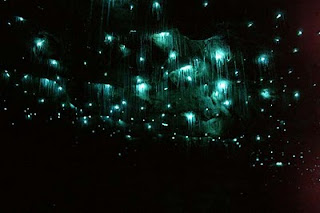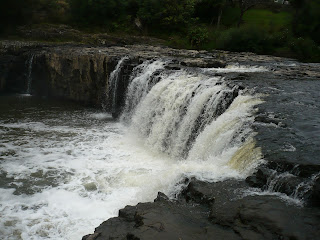Back before Christmas, all those years ago, we booked a trip to go to the very North of North Island,
Cape Reinga. So in the morning we were up with the lark to make sure we didn’t miss the bus that was going to take us there, and various other places of interest along the way. It’s important to make sure you’re outside your accommodation at the allotted time, and at 7:10 we were standing outside our motel for a 7:15 pick-up. The bus turned up, and on we got.
The bus then toured around various other hotels, motels, Holiday Inns etc around Paihia, picking up couples, families, and other parties. At the final stop, only 3 of the expected 5 people boarded. The driver checked around the place, called in at Reception, hung around for 5 minutes, but no sign of the last pair…so off we went. Half an hour down the road he gets a call on the radio, saying that he’d missed a pick-up. Not so, he countered, and told all. So be outside your accommodation on time, or pay the price!
The first port of call was at
Kauri Kingdom, which is basically a shop selling
kauri artefacts, with café attached, where we had breakfast. The kauri tree, you’ll remember from a couple of days ago, is a
New Zealand native pine that grows upwards and then outwards to prodigious girths. Felling of kauri is now illegal, partly due to the significance of the trees to Maori culture. There are around 1% of the original kauri trees left in
New Zealand.
So how can a shop sell kauri artefacts and furniture? They are made from what is known as “swamp kauri”, which is dead trees that have been preserved for over 45,000 years in the salt swamps of Northland. It is believed that the trees died because of nearby volcanic activity, and changes in sea levels have helped with their preservation. They are now recovered and worked into finished goods.
Next, we drove to 90 Mile Beach. This beach is classed as a road, and the rules of the road still apply, so you can be ticketed for speeding and other traffic violations whilst on it! It is only passable at a few hours either side of low tide, so the nature of the tour changes daily – on some days, the bus drives down the beach in the afternoon. The beach derives its name from an original estimate made in the 19th century, when teams of oxen would pull a cart along the beach from one end to the other. It took 3 days, and the rule of thumb was that oxen could cover 30 miles per day. Of course, they hadn’t figured that walking on sand was a bit harder, and when someone finally decided to measure it, it turned out to be only 55 miles long. But as Australia already had an 80 Mile Beach, there was no way that the Kiwis were going to rename it to something less than that, so the name has stayed the same.
We were driving into the teeth of a stiff Northerly, and when we stopped for photos the wind was quite strong – you could see it whipping spray off the breakers crashing on the beach, and sandblasting anyone and anything that stood in its way.
 |
| Heavy surf |
We hurriedly reboarded the bus, then drove up to the larger dunes, where we had a go at sand surfing. This involves climbing up a dune, then sliding down it on a body-board. Sounds easy, but it’s the climbing up the dune that’s the tricky bit – by the time you arrive at the top you’re knackered! Add to this the continual sand blowing in your face. Once at the top, you catch your breath for a few minutes before launching yourself down the dune on the board, using your toes to steer and brake as needed. Great fun! But one of the side-effects (apart from jelly legs) was that you felt that you were taking half the dune with you as left…and that gritty feeling stayed with us for the rest of the day. One or two people came off their boards, but no-one was hurt…as our driver told us as we drove away, and proceeded to regale us with tales of serious injury sustained whilst sand surfing, most of which appeared to have happened to him.
 |
| Faster than a speeding bullet |
At this point we left the beach, and rejoined the conventional road to drive up to
Cape Reinga. Our guide filled us in on the Maori legends surrounding the cape. As with many similar sites in
New Zealand and other parts of the world, the significance to the indigenous people was largely ignored during the 19
th and early part of the 20
th centuries, and it is only more recently that
Cape Reinga has been restored and proper facilities installed. As part of the regeneration of the area, there is a programme to plant indigenous wildlife throughout the cape, and we contributed to that by planting a
Hebe diosmifolia, for which we now have a certificate.
 |
| Planting our plant |
We stopped off for lunch, then hit the road again, heading for the Puketi kauri forest. This doesn’t contain the giant specimens of Waipoua forest that we visited on Sunday, but does have a good concentration of mature trees in sub-tropical rainforest. The thick mist we’d encountered at Cape Reinga had turned into drizzle, and then proper rain by the time we reached the forest walk, so we fairly whistled round. If we hadn’t seen Tane Mahuta a couple of days ago we might have been slightly more impressed by the trees. As it was, we were getting towards the end of a long day, and our minds were slightly more focussed on getting into a shower and washing all the sand off. True grit, indeed.












































